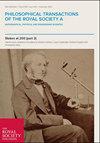氧同位素和早期太阳系
Philosophical Transactions of the Royal Society of London. Series A, Mathematical and Physical Sciences
Pub Date : 2001-10-15
DOI:10.1098/rsta.2001.0894
引用次数: 24
摘要
陨石保存了太阳系形成时期大量的氧同位素特征。这些岩石大多记录了复杂的历史,每一个阶段都有可能覆盖最初的氧特征。不平衡的普通球粒陨石通过球粒内部和次生磁铁矿中的同位素不平衡揭示了热液蚀变的证据,我们现在可以将其限制在140-180°C之间。这种蚀变的影响逐渐被后来的热变质作用所消除。进一步加热导致熔化(如球粒陨石所示),通过高精度分析产生明确的质量分馏线。碳质球粒陨石中低温矿物的氧显示出高度的同位素均匀性,表明水蚀变发生在开放系统条件下。普通球粒陨石中水的初始同位素组成与碳质球粒陨石中的水的初始同位素组成截然不同,但两者都落在一条斜率为1.0的直线上,初始无水硅酸盐组成也是如此。这表明,产生与质量无关的分馏的过程是陨石中看到的大多数氧同位素变化的原因。随后涉及这些成分的陨石母体的含水蚀变能够产生所观察到的全部变化。本文章由计算机程序翻译,如有差异,请以英文原文为准。
Oxygen isotopes and the early Solar System
Meteorites preserve a wide range of oxygen isotopic signatures from the time of the Solar System's formation. Most of these rocks record complex histories, each phase of which has the potential for overwriting initial oxygen signatures. The unequilibrated ordinary chondrites reveal evidence of hydrothermal alteration through isotopic disequilibrium within chondrules and in secondary magnetites, which we can now constrain to temperatures of 140–180°C. The effects of this alteration are progressively obliterated by later thermal metamorphism. Further heating leads to melting (shown in achondritic meteorites), producing well–defined mass–fractionation lines using high–precision analyses. The oxygen from low–temperature minerals in carbonaceous chondrites reveals high levels of isotopic uniformity, suggesting that the aqueous alteration occurred under open–system conditions. The initial isotopic composition of the water from the ordinary chondrites is quite distinct from that in the carbonaceous chondrites, but both fall on a single line of slope 1.0, as do the initial anhydrous silicate compositions. This is taken to show that a process generating a mass–independent fractionation was responsible for most of the oxygen–isotopic variation seen in meteorites. Subsequent aqueous alteration of the meteorite parent bodies involving these components is then capable of producing the full observed variation.
求助全文
通过发布文献求助,成功后即可免费获取论文全文。
去求助
来源期刊
自引率
0.00%
发文量
0

 求助内容:
求助内容: 应助结果提醒方式:
应助结果提醒方式:


